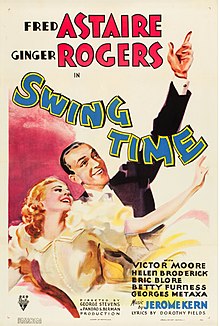
Back وقت الميل (فيلم) Arabic وقت الميل ARZ واختی دؤنون AZB Време за суинг Bulgarian En ales de la dansa Catalan Swing Time Welsh Swing Time German Swing Time Spanish چرخش زمان Persian Hääkarkuri Finnish
| Swing Time | |
|---|---|
 Theatrical release poster by William Rose | |
| Directed by | George Stevens |
| Screenplay by | Howard Lindsay Allan Scott Contributing writers (uncredited):[1] Dorothy Yost Ben Holmes Anthony Veiller Rian James |
| Story by | Erwin S. Gelsey "Portrait of John Garnett" (screen story)[1] |
| Produced by | Pandro S. Berman |
| Starring | Fred Astaire Ginger Rogers |
| Cinematography | David Abel |
| Edited by | Henry Berman |
| Music by | Jerome Kern (music) Dorothy Fields (lyrics) |
Production company | |
| Distributed by | RKO Radio Pictures |
Release dates |
|
Running time | 103 minutes |
| Country | United States |
| Language | English |
| Budget | $886,000[3] |
| Box office | $2.6 million[3] |
Swing Time is a 1936 American musical comedy film, the sixth of ten starring Fred Astaire and Ginger Rogers. Directed by George Stevens for RKO, it features Helen Broderick, Victor Moore, Betty Furness, Eric Blore and Georges Metaxa, with music by Jerome Kern and lyrics by Dorothy Fields. Set mainly in New York City, the film follows a gambler and dancer, "Lucky" (Astaire), who is trying to raise money to secure his marriage when he meets a dance instructor, Penny (Rogers), and begins dancing with her; the two soon fall in love and are forced to reconcile their feelings.
Noted dance critic Arlene Croce considers Swing Time to be Astaire and Rogers's best dance musical,[4] a view shared by John Mueller[5] and Hannah Hyam.[6] It features four dance routines that are each regarded as masterpieces. According to The Oxford Companion to the American Musical, Swing Time is "a strong candidate for the best of the Fred Astaire and Ginger Rogers musicals". The Oxford Companion says that, although the screenplay is contrived, it "left plenty of room for dance and all of it was superb. ... Although the movie is remembered as one of the great dance musicals, it also boasts one of the best film scores of the 1930s."[7] "Never Gonna Dance" is often singled out as the partnership's and collaborator Hermes Pan's most profound achievement in filmed dance, while "The Way You Look Tonight" won the Academy Award for Best Original Song, and Astaire topped the U.S. pop chart with it in 1936. Jerome Kern's score, the first of two that he composed specially for Astaire films, contains three of his most memorable songs.[8]
The film's plot has been criticized, though,[9] as has the performance of Metaxa.[4][5] More praised is Rogers's acting and dancing performance.[10] Rogers credited much of the film's success to Stevens: "He gave us a certain quality, I think, that made it stand out above the others."[5] Swing Time also marked the beginning of a decline in popularity of the Astaire–Rogers partnership among the general public, with box-office receipts falling faster than usual after a successful opening.[11] Nevertheless, the film was a sizable hit, costing $886,000, grossing over $2,600,000 worldwide, and showing a net profit of $830,000. The partnership never regained the creative heights scaled in this and previous films.[12]
In 1999, Swing Time was listed as one of Entertainment Weekly's top 100 films. In 2004, it was selected for preservation in the United States National Film Registry by the Library of Congress as being "culturally, historically, or aesthetically significant". In AFI's 100 Years...100 Movies (10th Anniversary Edition), it is ranked at No. 90.
- ^ a b Swing Time at the American Film Institute Catalog
- ^ Brown, Gene (1995). Movie Time: A Chronology of Hollywood and the Movie Industry from Its Beginnings to the Present. New York: Macmillan. p. 130. ISBN 0-02-860429-6.
- ^ a b Richard Jewel (1994) 'RKO Film Grosses: 1931–1951', Historical Journal of Film, Radio and Television, Vol. 14 No. 1, p.55
- ^ a b Croce, pp.98-115
- ^ a b c Mueller, pp.100-113
- ^ Hyam, Hannah (2007). Fred and Ginger – The Astaire-Rogers Partnership 1934–1938. Brighton: Pen Press Publications. ISBN 978-1-905621-96-5.
- ^ Hischak, Thomas. "Swing Time". The Oxford Companion to the American Musical, Oxford University Press 2009. Oxford Reference Online, accessed September 25, 2016 (requires subscription)
- ^ Mueller, p. 101n: "In a 1936 letter George Gershwin was somewhat patronizing about the music: 'Although I don't think Kern has written any outstanding song hits, I think he did a very credible job with the music and some of it is really quite delightful. Of course, he never was really quite ideal for Astaire and I take that into consideration'."
- ^ Mueller, p. 101: "the story is riddled with inconsistencies, implausibilities, contrivances, omissions, and irrationalities," Croce, p. 102: "discontinuities in the plot," also see Hyam, p. 46.
- ^ Mueller, p. 103: "her finest in the series".
- ^ Astaire, Fred (1959). Steps in Time. London: Heinemann. pp. 218–228. ISBN 0-241-11749-6.
- ^ Croce, p. 104: "Swing Time is an apotheosis."
© MMXXIII Rich X Search. We shall prevail. All rights reserved. Rich X Search